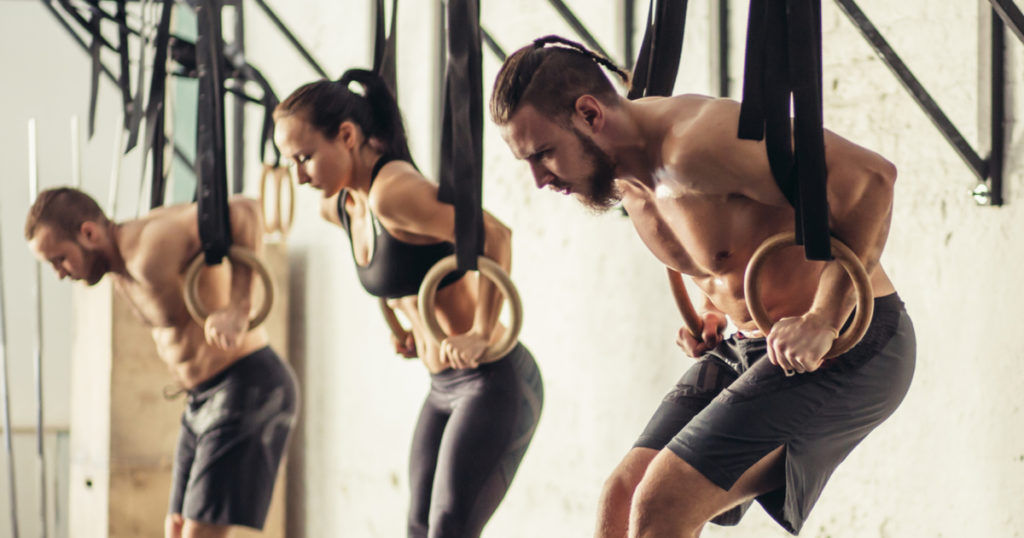5 Steps to Nailing Your First Muscle-Up | BarBend (original) (raw)
In this article, we will offer a 5-step muscle up progression guide. In recent articles, the muscle-up and its variations were covered in detail, however, in this guide we will specifically walk through how one can go about building necessary strength, skill, and confidence to perform a muscle up.
Therefore, in this article, we will discuss:
- Muscle-Up Prerequisites
- 5-Step Muscle-Up Progression Guide
- Advanced Muscle-Up Progressions
Muscle-Up Prerequisites
Muscle-ups are a complex bodyweight exercise that require strength, joint stability, and body control. In order to safely attempt to learn the muscle-up, one must have already established bodyweight strength, stability, and coordination. Failure to do so can result in injury, excessive loading and strain on the joints and connective tissue, and sidelining shoulder/elbow/wrist injuries.
Before attempting the following muscle-up progressions, it is recommended that you be able to perform the below prerequisites with proper form and control.
- 10-15 Strict Pull Up (Regular and/or Chest-to-Bar)
- 10-15 Strict Ring Dips
- Support Hold on Dips
The above prerequisites are general recommendations. If you are unsure if you are ready, then practice these beginner muscle-up progressions and find a qualified coach.
5-Step Muscle Up Progression Guide
1. Build Bodyweight Strength
As discussed above, building bodyweight strength using pull-ups, chin-ups, push-ups, dips, l-sits, planks, and more are all necessary aspects of muscle-up training. Once you have increased bodyweight strength, you can include tempos, holds, and other challenging variations to improve body control, muscle endurance, and injury resilience.
- Begin Here: Start with 3-4 sets of strict pull-ups and ring dips
- Make It Harder: Integrate kipping, tempos, and other variations into the mix as you progress.
Below are more bodyweight exercises you should master!
2. Master Positional Holds on Rings
Assuming you are looking to perform a ring muscle-up (if you are using a bar, do this step using a bar), then you need to acclimate yourself and develop isometric strength and control at challenging positions. By performing timed holds at the bottom of the dip, top of the dip, and throughout the muscle-up’s full range of motion; you can increase coordination, muscle firing, and minimize instability of the joints.
- Being Here: Start by performing 20-30 second support holds at the bottom and top of the ring dip, focusing on using the muscles rather than collapsing on the joints.
- Make It Harder: Perform longer holds and pause repetitions as you advance.

Photo By UfaBizPhoto / Shutterstock
3. Practice Assisted Muscle-Up Transitions
The turnover/transition phase of the muscle-up is often the most challenging part of the movement, as it requires strength, power, stability, and confidence. Many individuals lose body control in the phase as they often lose rigidity trying to perform an aggressive kipping movement.
Understanding how to properly transition in the ring muscle-up, or bar for that matter, is key for muscle-up success, but more importantly at ensuring proper shoulder position to minimize injury. Using low rings (allowing lifter to be seated/standing on the floor), assistance bands, and/or even a partner can help to improve this crucial step in the muscle up process.
- Begin Here: Start from a seated position or standing on the floor.
- Make It Harder: Remove contact points on the floor, and increase the height of the rings.
4. Understand Kipping and How Much Is Enough
Once you have built the strength, technical awareness of the turnover, and are starting to grasp the movement as a whole, you need to learn how to properly perform kips and kipping rows. To learn the muscle-up, you must master both kipping and ring rows while suspended in the air. This takes a great amount of core stability, body control, and timing.
- Begin Here: Start by kipping on rings and establish a bigger kip as you build confidence and control.
- Make It Harder: Once you have become controlled and confident, add a row onto the top of the kip, so that your chest and hips are facing upwards (lie back) at the top of the kip. This will then help you easily transition into a dip position.
5. Put It All Together
Once you have mastered the above steps, it is time to start putting the individual components together into the full muscle-up. It is recommended that you perform these under the guidance of a skilled, trained, and qualified coach to minimize risk of injury and speed up the learning process.
3 Advanced Muscle-Up Progressions
Below are three advanced muscle up progression to improve strength, muscular endurance, skill, and stability.
1. Strict Muscle-Up
The strict muscle-up is a muscle-up without a kip, which requires high amounts of upper body strength of the back, biceps, shoulders, chest, and triceps.
2. Muscle-Up Complexes
Muscle-up complexes can be done to increase training volume of certain aspects of the muscle-up. For example, performing one muscle-up, and then 5 dips, you can work to isolate certain segments of the muscle-up that may need additional training, while still having direct application to the movement.
3. Weighted Muscle-Ups
Weighted muscle-ups, while only advised for more advanced individuals, can be done to increase difficulty and ultimately make bodyweight muscle ups easier. The amount of external load should be kept light, think 5-15lbs.
Master These Bodyweight Exercises
Mastering your bodyweight can improve your fitness, muscle coordination and control, and have direct application to gymnastic movements. Check out the below bodyweight guides and master your body!
Feature image from UfaBizPhoto / Shutterstock